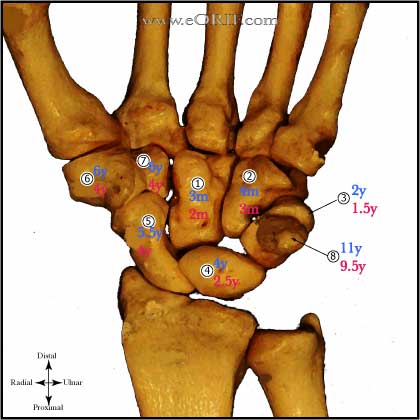|
synonyms:
Madelung’s Deformity ICD-9
- 755.54 Madelung's Deformity
Madelung’s Deformity Etiology / Epidemiology / Natural History
- growth disturbance of the ulnar, palmar aspect of the distal radial epiphysis
- may be combination of a bony leasion in ulnar portion of distal radial physis and abnormal palmar ligament tethering lunate to radius proximal to physis
- most commonly caused by dysplasia associated with Leri-Weill syndrome(dyschondrosteosis)-AD 50% penetrance
- may be caused by repetive loading(gymnast wrist))
- female > male
Madelung’s Deformity Anatomy
- normal distal radial epiphysis appears at 2 and begins to flatten at 6yrs
- associated with Vicker's ligament (thick volar ligament which tethers the lunate to the distal radius.
Madelung’s Deformity Clinical Evaluation
- Most common complaint-writst deformity becoming noticeable between 8-12 yrs old.
- Pain is uncommon.
- Weakness due to subluxation of the wrist into radioulnar space and limited rotation are common
Madelung’s Deformity Xray / Diagnositc Tests
- PA, Lateral wrist films
- Diagnostic criteria: any one of the following: ulnar tilt >33, lunate subsidence >4mm, lunate fossa angle of > 40 or palmar carpal displacement >20mm. (J Hand Surg 2010)
Madelung’s Deformity Classification / Treatment
- Asymptomatic: no treatment necessary.
- Symptomatic (painfu), skeletally immature: physiolysis(resection of arrested growth plate) indicated.
- Symptomatic, skeletally mature=radial and dorsal closing wedge osteotomy and ulnar shortening (Harley, BJ, J Hand Surg 2006;31A:1499).
- may cause spontaneous extensor tendon ruptures.
Madelung’s Deformity Associated Injuries / Differential Diagnosis
- Osteochondromatosis
- Skeletal dyspasia
- Ler-Weill Syndrome
- Distal radial physeal arrest
- Infection
Madelung’s Deformity Complications
Madelung’s Deformity Follow-up Care
Madelung’s Deformity Review References
|

